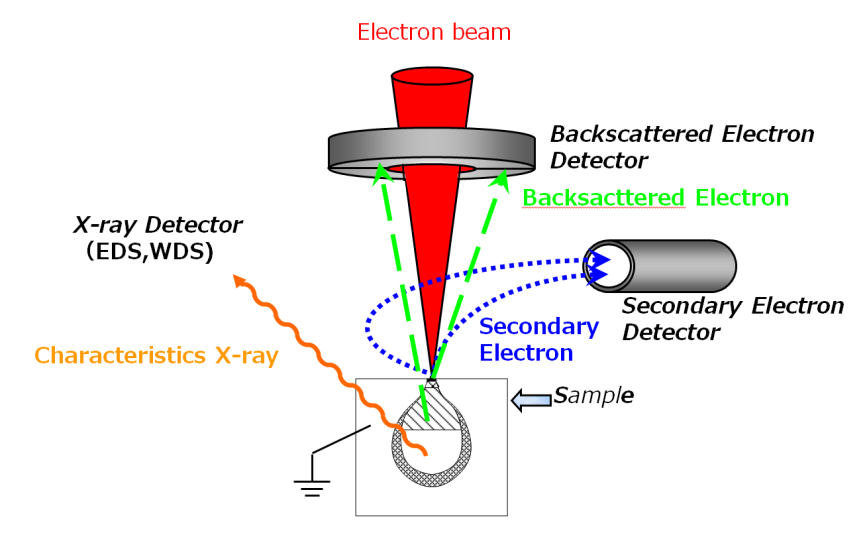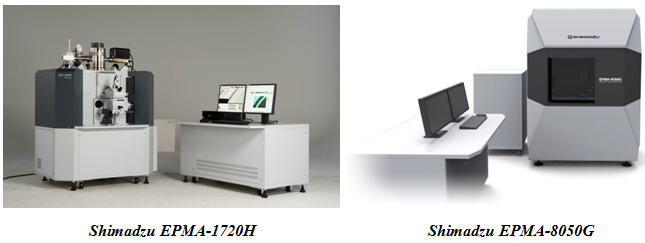News
What’s EPMA ?
Electron Probe Micro Analyzer(EPMA) is one of the instruments to analyze solid substances. EPMA works by bombarding a sample with an accelerated and focused electron beam that cause various interactions between the electron of beam and the atoms of all elements included in the sample.
EPMA can do fully qualitative and quantitative analysis at the micro-sized volumes of the surface of sample. Generally most of analytical instruments can do only qualitative and quantitative analysis, but EPMA has more analysis modes than any other instruments. Not only qualitative and quantitative analysis but also EPMA can do line analysis, mapping analysis and state analysis.


Fig 1. Show bombarding a sample with an accelerated and focused electron beam

Fig 2. Results of qualitative and quantitative analysis by EPMA


Fig 3. Results of mapping analysis
EPMA is the hybrid instrument combining the capabilities of SEM (scanning electron microscope) and elemental analyzer but EPMA provides much better results compared with SEM/EDS by WDS (EDS) spectrum, higher spectrum resolution and sensitivity.

Fig 4. Model EPMA-1720H and EPMA-8050G commonly of Shimadzu
Today EPMA is widely used for Q&A and R&D in various fields, please refer below table.
|
Fields |
Main Applications |
|
Mining |
Ore analysis, etc. |
|
Construction |
Concrete analysis (reaction to alkaline aggregates, sale damage, etc.) |
|
Fibers |
Distribution of particles contained among fibers (for commuter footwear) |
|
Pulp and Paper |
Observation and analysis of coated paper cross sections, etc. |
|
Pharmaceuticals |
Analysis of foreign matter content, discoloration, or other defects, new drug development, etc. |
|
Rubber Products |
Analysis of foreign matter content, discoloration, or other defects, new material development, etc. |
|
Ceramics (glass, etc.) |
Analysis of glass striae or other defects, new material development, etc. |
|
Steel |
Analysis of segregation, inclusions, or other defects, new material development, etc. |
|
Nonferrous Metals |
Analysis of segregation, inclusions, or other defects, new material development, etc. |
|
Electrical/Electronic Goods |
Defect analysis at the part level or new product development |
|
Transportation Equipment |
Defect analysis at the part level or research of LIB/catalysts, etc. |
|
Electricity and Gas |
Catalyst and other energy-related research |
Please contact us for advice and more information.
(Reference from application News - Shimadzu Corporation)
Source: ETA
Others
- TECOTEC GROUP ATTENDED SHIMADZU’S SERVICE MANAGER MEETING IN 2022
- TECOTEC HANDED OVER EDX-7000 X-RAY FLOURESCENCE SPECTROMETER AT NIDEC CHAUN CHOUNG VIETNAM
- INSTALLATION OF CHIP PROCESSING SYSTEM – LANNER/ GERMANY
- TECOTEC completed installation of EDX-LE Energy dispersive X-ray Fluorescence spectrometer at DYT Vina
- TECOTEC DELIVERED AND INSTALLED THE 2ND X-RAY FLUORESCENCE SPECTROMETER - EDX-LE PLUS AT TABUCHI
- TECOTEC Group has handed over PDA-7000 Optical Emissions Spectrometers for Nihon Plast Vietnam
- Bowman XRF Coating Measurement System For Electroless Nickel Plating
- TECOTEC DELIVERED AND INSTALLED SMX-2000 SYSTEM TO NIDEC TECHNO MOTOR VIETNAM



